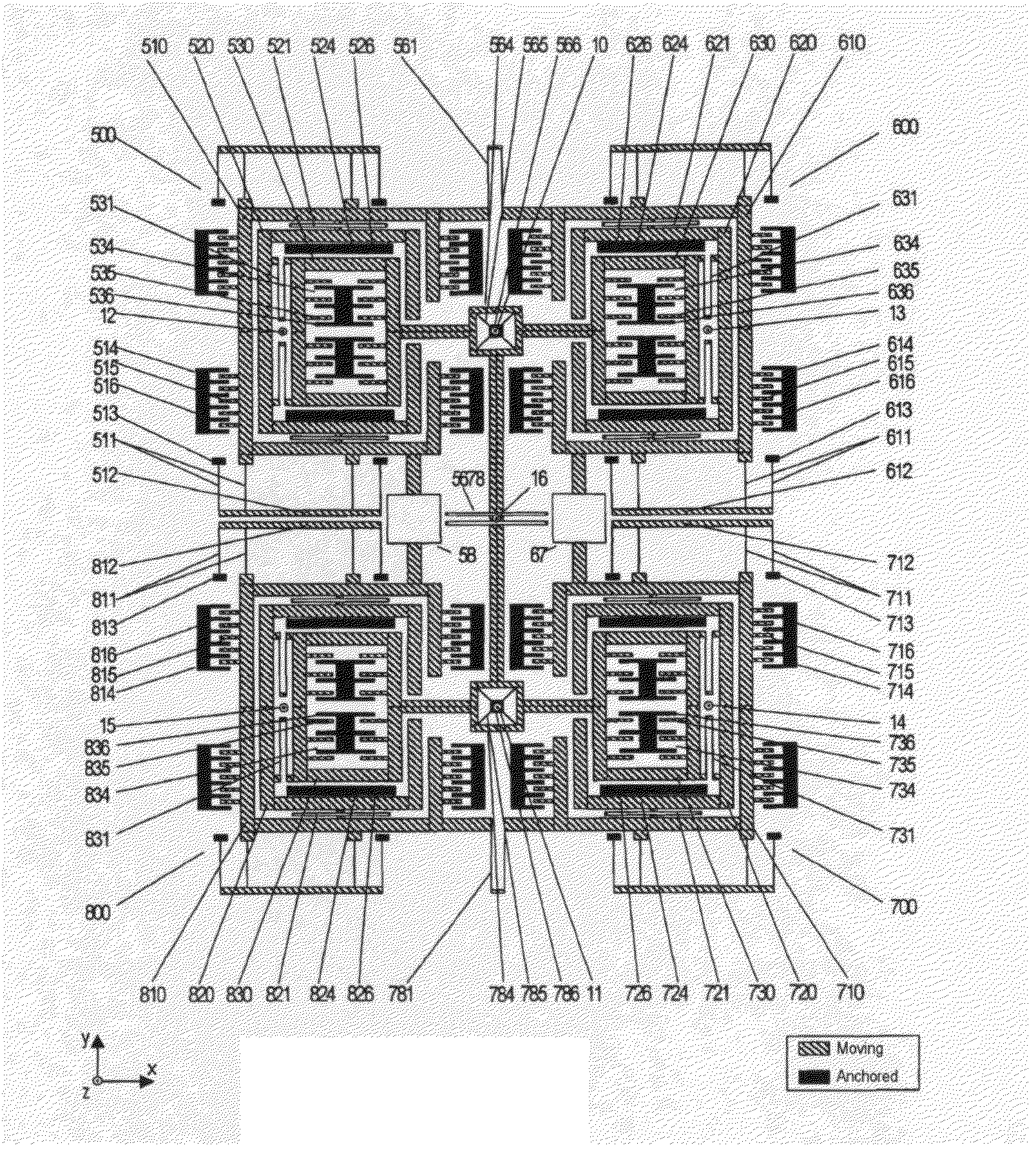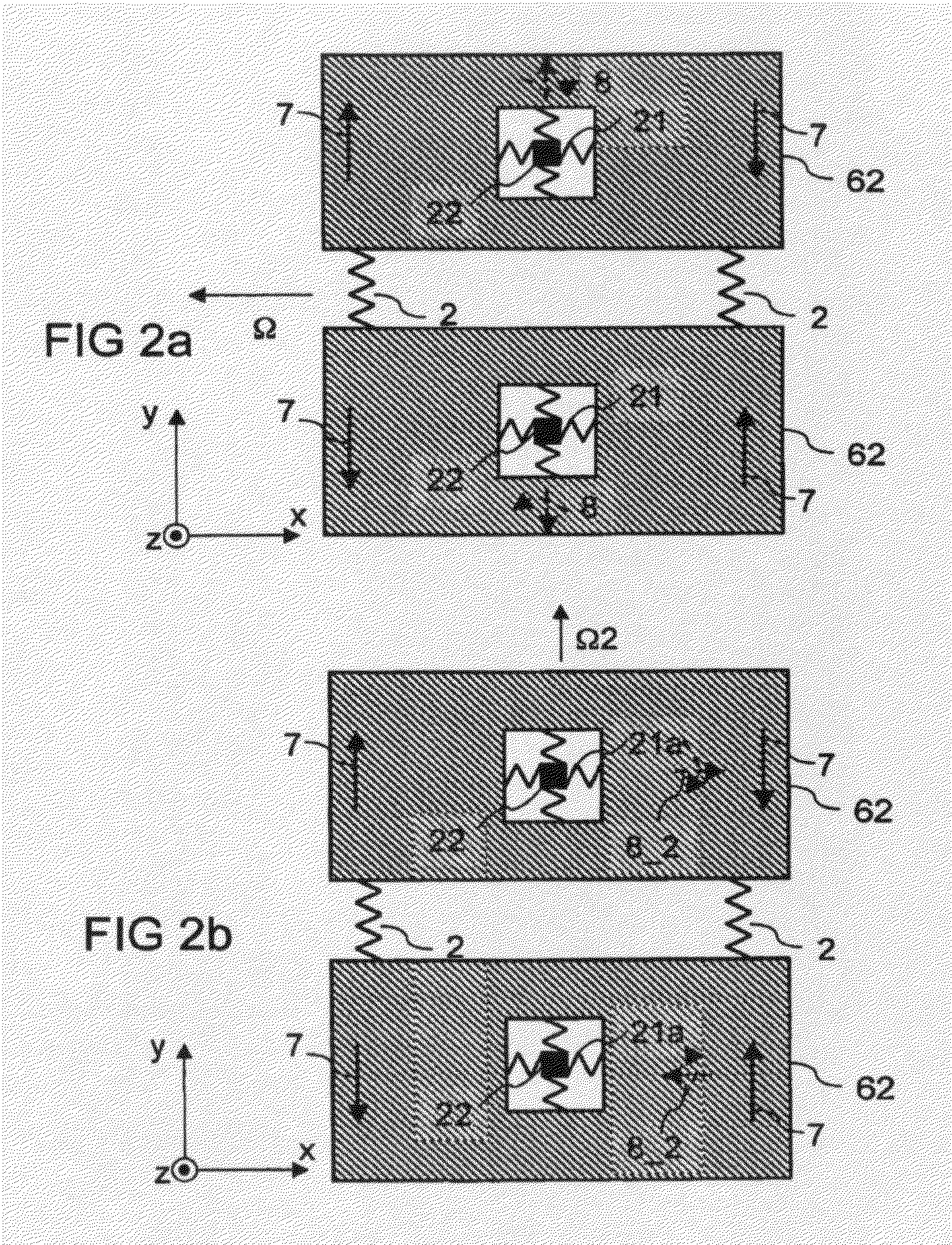Coriolis gyro
a technology of coriolis and gyros, applied in the field of coriolis gyros, can solve the problems of quadrature compensation, i.e., virtually impossible “balancing-out” of the structure by an actuating element, and requires complex manufacturing processes. , to achieve the effect of reducing the sensitivity to acceleration and vibration
- Summary
- Abstract
- Description
- Claims
- Application Information
AI Technical Summary
Benefits of technology
Problems solved by technology
Method used
Image
Examples
first embodiment
[0025]FIG. 1 is a mechanical schematic diagram of a Coriolis gyro based on a spring and mass system, in a first embodiment, having four first mass elements 61 coupled via first x coupling spring elements 1a and coupling spring elements 2 to one another. The described elements are coupled via second x coupling spring elements 1b, connecting elements 4 and first substrate spring elements 3 to a substrate 5 (shown in FIG. 1 by means of an anchor). Two coupled out-of-phase linear oscillations of the mass elements 61, again out-of-phase with respect to one another, serve as the excitation mode 7. When the Coriolis gyro is rotated about a sensitive axis Ω, a detection mode 8 is excited (represented as two coupled out-of-phase rotary oscillations about a y axis parallel to the sensitive axis Ω and at right angles to the x direction (Lin-Rot)). The x coupling spring elements 1a, 1b are soft in the x direction, and otherwise stiff. The coupling spring elements 2 may be isotropically soft (i....
second embodiment
[0026]FIG. 2a is a schematic diagram of a Coriolis gyro based on a spring and mass system in a In this embodiment, two second mass elements 62 are coupled by coupling spring elements 2 to one another and are coupled via second substrate spring elements 21 to a substrate 5 (illustrated by an anchor 22). Two coupled out-of-phase rotary oscillations of the mass elements 62 about the substrate anchor 22, about a z direction, serve as the excitation mode 7. During rotation of the Coriolis gyro about its sensitive axis Ω, two coupled out-of-phase rotary oscillations about a y axis are excited (Rot-Rot) as the detection mode, and are at right angles to the sensitive axis Ω and to the rotation axis z of the excitation mode 7. The second substrate spring elements 21 are soft during rotation about the z and y axes, but are otherwise as stiff as possible. The coupling spring elements 2 may be isotropically soft (i.e. soft for all loads). In the case of this Coriolis gyro the useful modes (i.e...
third embodiment
[0028]FIG. 3 is a schematic diagram of a Coriolis gyro based on a spring and mass system. Four third mass elements 63 are coupled via xy coupling spring elements 23 to one another and to a substrate 5 (illustrated by an anchor 24). Linear oscillations of the mass elements 63 at 45° to the x and y directions are used as the excitation mode 7. In this case, two obliquely opposed third mass elements 63 each move towards one another when the respective other two opposed third mass elements 63 move away from one another. During rotation of the Coriolis gyro about the sensitive axis Ω (at right angles to the x and y directions and therefore parallel to the z direction), a linear oscillation is excited as the detection mode, and is shifted with respect to the excitation mode (Lin-Lin). In this case, the third mass elements 63, which are adjacent in the x direction, move towards one another in the x direction when third mass elements 63, adjacent in the y direction, are moving away from one...
PUM
 Login to View More
Login to View More Abstract
Description
Claims
Application Information
 Login to View More
Login to View More - R&D
- Intellectual Property
- Life Sciences
- Materials
- Tech Scout
- Unparalleled Data Quality
- Higher Quality Content
- 60% Fewer Hallucinations
Browse by: Latest US Patents, China's latest patents, Technical Efficacy Thesaurus, Application Domain, Technology Topic, Popular Technical Reports.
© 2025 PatSnap. All rights reserved.Legal|Privacy policy|Modern Slavery Act Transparency Statement|Sitemap|About US| Contact US: help@patsnap.com



